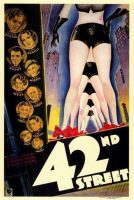42nd Street movie storyline. Renowned Broadway producer / director Julian Marsh is hired to put together a new musical revue. It’s being financed by Abner Dillon to provide a starring vehicle for his girlfriend, songstress Dorothy Brock. Marsh, who is quite ill, is a difficult task master working long hours and continually pushing the cast to do better. When Brock breaks her ankle one of the chorus girls, Peggy Sawyer, gets her big chance to be the star. She also finds romance along the way.
42nd Street (1933) is the classic, fast-paced, backstage movie musical – a refreshing film that changed the film musical forever and saved Warner Bros. studios from bankruptcy, helping it grow into a major studio. Set during the Depression and about the Depression, film is considered the backstage musical par excellence, the grand-daddy of them all. It was based on the ‘putting-on-a-show’ tradition stemming from MGM’s first sound film, The Broadway Melody (1929), another “backstage musical.”
Its skillful direction was provided by Lloyd Bacon, with a funny, often sardonic screenplay by Rian James and James Seymour, and the film was nominated for Best Picture. The film succeeded by mixing veteran stars (George Brent, Warner Baxter and Bebe Daniels) with virtual new-comers (Ginger Rogers, Dick Powell and Ruby Keeler), and exotic chorus girls in abundance.
42nd Street was the first of three landmark musical films released in 1933 by Warner Bros. to revitalize the musical film genre (the other two films were Gold Diggers of 1933 (1933) and Footlight Parade (1933)). In contrast to the fantasy, escapist romantic dance musicals of Fred Astaire and Ginger Rogers that also began in the same year (Flying Down to Rio (1933)), this film was an unglamorized look at the tough realities of backstage life behind the footlights. The urban milieu of the film is filled with crisp, slangy, bitter dialogue and wisecracks, street-wise characters, topical references, desperately-striving chorines, dancers, and crew, and down-and-out references to the Depression.
As well as being one of the most commercially-successful films of its time, it was also the first major work of Busby Berkeley, a tremendously talented choreographer, whose direction of voyeuristic, surrealistic production numbers is illustrated in extravagant, musical numbers, giant kaleidoscopes of imagery, dancing girls forming abstract designs and patterns, and innovative camera images. He was particularly known for his overhead shots, freely-moving camera (dollies and pans), and for creating numbers especially-made for films that went far beyond conventional boundaries.
42nd Street (1933)
Directed by: Lloyd Bacon
Starring: Warner Baxter, Bebe Daniels, George Brent, Ruby Keeler, Guy Kibbee, Una Merkel, Ginger Rogers, Ned Sparks, Dick Powell, Allen Jenkins, Edward J. Nugent, Robert McWade, George E. Stone
Screenplay by: Rian James, James Seymour
Cinematography by: Sol Polito
Film Editing by: Thomas Pratt, Frank Ware
Costume Design by: Orry-Kelly
Art Direction by: Jack Okey
MPAA Rating: None.
Distributed by: Warner Bros. Pictures
Release Date: March 11, 1933
Visits: 2461

